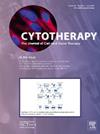基于CRISPR/ cas9的细胞因子诱导SH2蛋白敲除胃肠道肿瘤浸润淋巴细胞的临床制造
IF 3.2
3区 医学
Q2 BIOTECHNOLOGY & APPLIED MICROBIOLOGY
引用次数: 0
摘要
IV期胃肠道(GI)癌的预后较差,结直肠癌的5年生存率为15%。为了提高肿瘤浸润淋巴细胞(TIL)的疗效,我们分离了突变反应性的自体TIL,并利用CRISPR/Cas9敲除(KO)细胞内检查点蛋白CISH,该蛋白已被证明可以增强T细胞的扩增、功能亲和性和细胞因子的多功能性,从而在动物模型中使已建立的肿瘤持续消退。材料与方法:从切除的肿瘤碎片中培养TIL,在收获和冷冻保存前保持6周。候选新抗原通过外显子组测序和肽鉴定突变反应性(MR) TIL。选择的MR TIL解冻后,在含有10% AB血清、6000 IU/mL IL-2、5 ng/mL IL-7和IL-15的培养基中恢复24-36小时,然后用板结合抗cd3 /可溶性抗cd28刺激4天。通过电穿孔Cas9 mRNA和化学修饰的单导RNA进行CISH KO。将500 - 750万个活细胞添加到每100 cm2的G-Rex容器中,其中含有600 mL扩增培养基(异体饲养器MNC:TIL = 100:1),孵育6-8天。根据细胞浓度标准(和剂量队列)对培养物进行评估和分裂,并再孵育6-8天。第14天,收集所有细胞,用缓冲液洗涤并冷冻保存(5% DMSO)。批释放检测包括:活力、%CD3+、细胞学检查、革兰氏染色、无菌、内毒素、支原体和干扰素γ (IFN-γ)的产生。其他测试包括DNA测序以确定基因组CISH编辑效率和Western blot以确定CISH蛋白损失。结果:胃肠道肿瘤(结肠[10]、直肠[8]、胰腺[1]、食管[1])患者行肿瘤收集术。来自20例患者的22例肿瘤活检中有19例进行了KO/扩张。最终TIL产品结果(平均[SD],中位数[范围])为:活菌计数(x 1010) -3.25 (3.67), 1.95 (0.018-12.40);存活TIL倍数扩增-327.1 (364.8),153.1 (8-1454);%存活率- 76 (13),78 (43-92);% cd3 -94.4 (5.4), 95.8 (78.6-99.4);% CISH KO效率- 75 (29),87 (0-96);%编辑效率- 59.9(24.8),66.9(0.4-86)。5个TIL产品的生存能力降至70%以下。所有其他批号放行测试均符合规格要求。13例患者接受TIL治疗;6例患者在预期输注前因疾病进展未接受治疗。结论:基于CRISPR/ cas9的CISH KO MR TIL从基础研究实验室转化为当前的良好生产规范(cGMP)设施是成功的,允许优化,大规模扩展,支持首次用于治疗转移性胃肠道癌症患者的人体临床试验(ClinicalTrials.gov标识符:NCT04426669)。本文章由计算机程序翻译,如有差异,请以英文原文为准。
Clinical manufacture of CRISPR/Cas9-based cytokine-induced SH2 protein knock-out tumor-infiltrating lymphocytes for gastrointestinal cancers
Introduction
The prognosis of stage IV gastrointestinal (GI) carcinomas is poor with a 15% five-year survival rate for colorectal carcinomas. To improve efficacy of tumor infiltrating lymphocytes (TIL), we isolated mutation-reactive autologous TIL and employed CRISPR/Cas9 to knockout (KO) the intracellular checkpoint protein CISH, which has been shown to enhance T cell expansion, functional avidity, and cytokine polyfunctionality, with consequent durable regression of established tumors in an animal model.
Materials & Methods
TIL cultures were initiated from resected tumor fragments and maintained for six weeks before harvest and cryopreservation. Candidate neoantigens were nominated by exome sequencing and peptides were used to identify mutation reactive (MR) TIL. Selected MR TIL were thawed and allowed to recover for 24–36 h in media with 10% AB serum, 6000 IU/mL IL-2, and 5 ng/mL IL-7 and IL-15 followed by stimulation with plate-bound anti-CD3/soluble anti-CD28 for 4 days. CISH KO was performed by electroporation of Cas9 mRNA and chemically modified single guide RNA. Between 5 -7.5 million viable cells were added to each 100 cm2 G-Rex vessel containing 600 mL expansion media (with allogeneic feeder MNC:TIL = 100:1) and incubated for 6–8 days. Cultures were evaluated and split according to cell concentration criteria (and dose cohort) and incubated for an additional 6-8 days. On day 14, all of the cells were harvested, washed with buffer and cryopreserved (5% DMSO). Lot release testing included: viability, %CD3+, cytology review, Gram stain, sterility, endotoxin, mycoplasma, and interferon gamma (IFN-γ) production. Additional testing included DNA sequencing to determine genomic CISH editing efficiency and a Western blot for determination of CISH protein loss.
Results
Patients with GI cancers (colon [10], rectal [8], pancreatic [1], and esophageal [1]) underwent tumor collection. Nineteen of 22 tumor biopsies sampled from 20 patients total proceeded to KO/expansion. Final TIL product results (mean [SD], median [range]) were: viable count (x 1010) -3.25 (3.67), 1.95 (0.018–12.40); viable TIL fold expansion -327.1 (364.8), 153.1 (8–1454); % viability - 76 (13), 78 (43–92); % CD3 -94.4 (5.4), 95.8 (78.6–99.4); % CISH KO efficiency – 75 (29), 87 (0–96); % editing efficiency - 59.9 (24.8), 66.9 (0.4–86). Viability fell below 70% for five TIL products. All other lot release testing has met specification. Thirteen patients have received TIL; six patients were not treated due to disease progression prior to anticipated infusion.
Conclusion
The translation of CRISPR/Cas9-based CISH KO MR TIL from the basic research lab to current good manufacturing practices The (cGMP) facility was successful, allowing for optimized, large-scale expansion in support of a first-in-human clinical trial to treat patients with metastatic GI cancers (ClinicalTrials.gov Identifier: NCT04426669).
求助全文
通过发布文献求助,成功后即可免费获取论文全文。
去求助
来源期刊

Cytotherapy
医学-生物工程与应用微生物
CiteScore
6.30
自引率
4.40%
发文量
683
审稿时长
49 days
期刊介绍:
The journal brings readers the latest developments in the fast moving field of cellular therapy in man. This includes cell therapy for cancer, immune disorders, inherited diseases, tissue repair and regenerative medicine. The journal covers the science, translational development and treatment with variety of cell types including hematopoietic stem cells, immune cells (dendritic cells, NK, cells, T cells, antigen presenting cells) mesenchymal stromal cells, adipose cells, nerve, muscle, vascular and endothelial cells, and induced pluripotential stem cells. We also welcome manuscripts on subcellular derivatives such as exosomes. A specific focus is on translational research that brings cell therapy to the clinic. Cytotherapy publishes original papers, reviews, position papers editorials, commentaries and letters to the editor. We welcome "Protocols in Cytotherapy" bringing standard operating procedure for production specific cell types for clinical use within the reach of the readership.
 求助内容:
求助内容: 应助结果提醒方式:
应助结果提醒方式:


